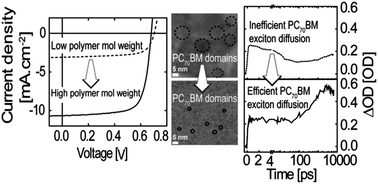Towards optimisation of photocurrent from fullerene excitons in organic solar cells†
Abstract
Photocurrent from fullerene excitons in polymer–fullerene solar cells is optimised by employing a series of low bandgap diketopyrrolopyrrole-containing polymers with differing molecular weights. The low LUMO level of this donor polymer prevents efficient charge generation from polymer excitons, allowing us to focus on charge and photocurrent generation specifically from fullerene excitons. We employ femtosecond transient absorption spectroscopy and transmission electron microscopy to show a correlation between fullerene domain size and the kinetics of polaron generation from fullerene excitons, and relate these observations to device efficiency. Charge generation from fullerene excitons is shown to occur on the 0.5 ns timescale, limited by the kinetics of diffusion of fullerene excitons to domain interfaces with donor polymers. For devices employing the highest molecular weight donor polymer, ∼7 mA cm−2 of photocurrent is observed from fullerene excitons, leading to an overall device efficiency of 5.2%.


 Please wait while we load your content...
Please wait while we load your content...